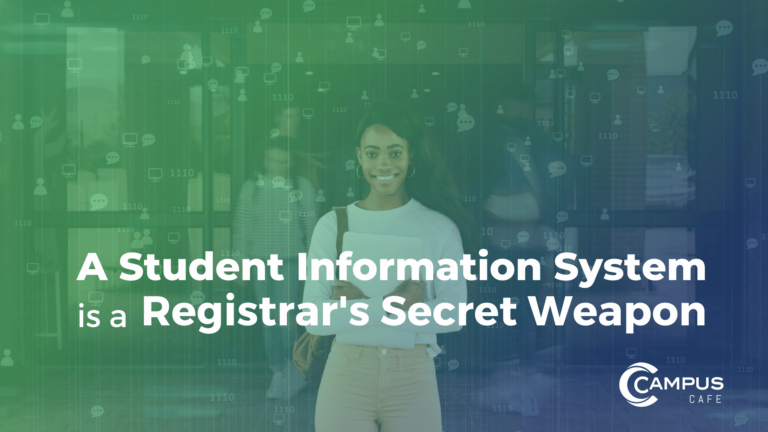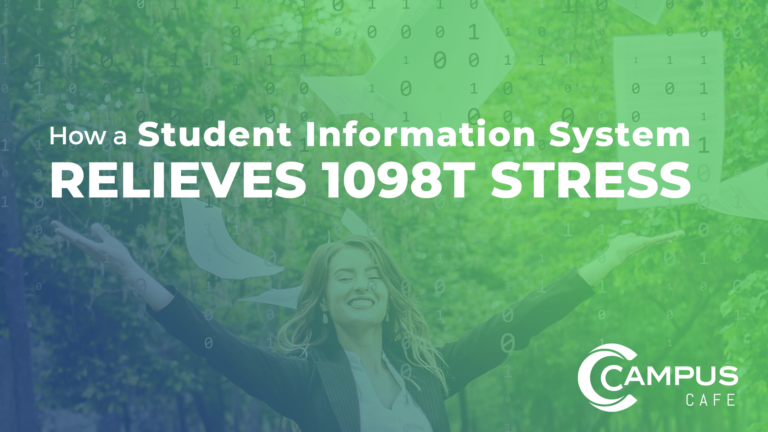
What to Know and Where to Start
When consumers shop for new products or services, they often look for a seal of approval from a governing body, which provides credibility and confidence. In higher education, that vote of confidence comes in the form of accreditation.
Higher education accreditation from an independent third party creates standards for institutions and academic programs while giving students and prospective employers confidence in the quality of a program or institution.
But accreditation isn’t just a rubber stamp. It’s a labor-intensive process that requires many layers of organization, documentation and collaboration.
For smaller institutions that want to scale their growth, accreditation can be a differentiator in the competition to attract and retain students.
This guide will provide an overview of the accreditation process based on school type and outline how technology can support a school’s accreditation goals. Click the section links below to jump ahead:
- I. Higher Education Accreditation: An Overview
- II. Five Reasons Students Prefer Accredited Schools
- III. Three Components of Accreditation
- IV. Accreditation by Type of School
- V. Departments Involved in the Accreditation Process
- VI. How a Student Information System Helps Schools Meet Accreditation Requirements
I. Higher Education Accreditation: An Overview
Higher education accreditation is certification from a private, nongovernmental organization that reviews the quality of non-profit and career schools and evaluates their programs.
Accrediting bodies are typically private educational associations that evaluate standards and collect peer reviews to determine if an institution meets its standards. The process is voluntary, and schools that apply for certification and hit benchmarks receive the appropriate accreditation.

The goal of accreditation is to ensure that education provided by higher education institutions meets acceptable levels of quality.
U.S. Department of Education
How Accreditation Impacts Funding
Once a school receives approval from a federally recognized accrediting body, it is granted accreditation by the appropriate federal and state government agencies and is eligible for federal and state funding.
Only schools accredited by a federally approved agency can administer Title IV financial aid, including loans, grants and work-study.
State accreditation allows a school to access state funds and permits students to take state licensing exams in some professional fields, such as nursing, law or teaching.
Types of Accreditation
The U.S. The Department of Education and the Council for Higher Education Accreditation (CHEA), a partner private association, oversee various accrediting agencies. A 17-member board governs the CHEA.
Non-profit colleges and universities earn accreditation from one of 19 recognized national or regional institutional accrediting organizations, while there are about 60 programmatic accrediting agencies. There are three types of higher education accreditation: national institutional accreditation, regional institutional accreditation and programmatic accreditation.
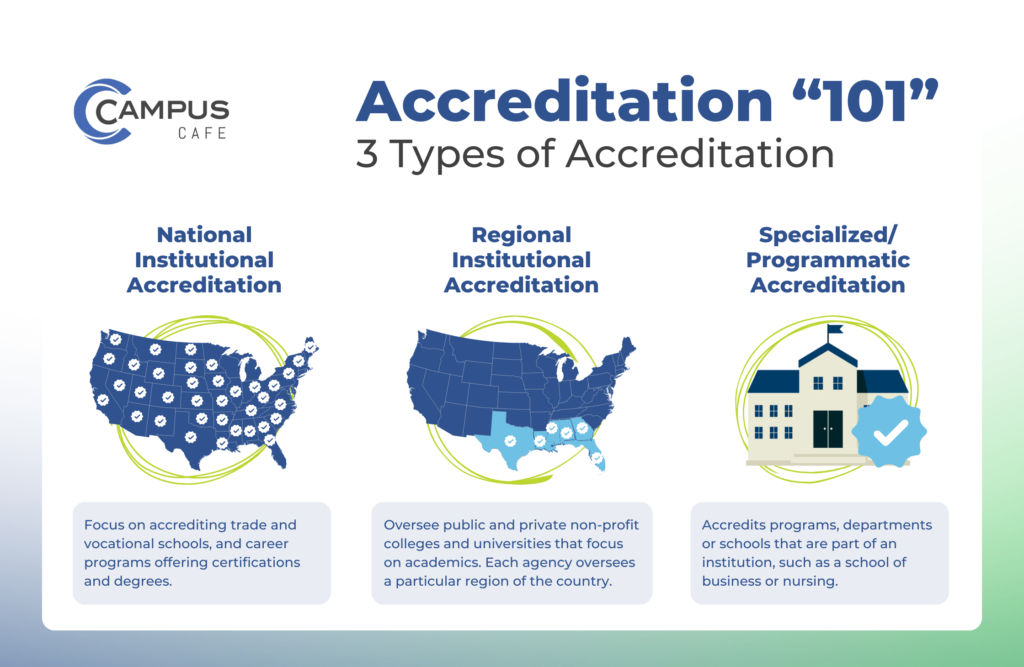
Cost of Accreditation
While expenses vary widely based on the accrediting agency, size and scope of the institution, and program types, accreditation is an investment, but one that pays dividends. CHEA estimates a school might spend $5,000 on application fees, between $2,500 and $6,000 for site visits, and about $3,000 per year on annual membership fees.
II. Five Reasons Students Prefer Accredited Schools
Students who want to attend a post-secondary institution are generally steered toward accredited schools and cautioned against attending a school without accreditation. Here’s why schools with a higher education accreditation have a competitive advantage.
1. Access to Federal Financial Aid
With the rising cost of tuition, most students need some form of financial aid. But under Department of Education policy, only accredited schools can administer Title IV federal financial aid to their students.
2. Transferrable Credits
If a student moves from one institution to another, they usually want to transfer their credits. While decisions on transfer credits are made at the school level on an individual basis, moving from one accredited school or program to another makes it more likely to have their transfer requests approved.
3. Professional Licensing
For some non-profit and career school degree programs, students are required to take state licensing exams to practice their profession, including law, health care, education and some professional trades such as electricians. States may require students to graduate from an accredited program to sit for exams and receive licenses.
4. Reputational Status
When a school or program is accredited by a federally recognized agency, that’s a reputation asset. Prospective students and employers look for accreditation to ensure a school or degree program is up to professional standards.
5. Access to Research Funding
In some instances, accreditation is required to access research funding. Funding agencies may prioritize institutions with high standards and a proven commitment to a quality education.
In short, prospective students want to feel confident knowing that an investment in their education will pay. Accreditation provides that assurance.
III. Three Components of Accreditation
When a school or program applies for accreditation, there are three steps that all schools must take. Key to this process is ensuring that your school’s critical documents are easily accessible, accurate and up to date for the teams responsible for spearheading the accreditation process.
1. Self-Reporting
The Higher Education Act requires accrediting agencies to submit an application that details a wide range of activities at each school or program.
This may include information on faculty; recruiting and admissions; student support services; curriculum; facilities; financial information; and administration details. To comply, schools are required to assemble a self-report of their activities and qualifications.
2. Site Visits
As part of the process, agencies send volunteers from other institutions to visit schools and review the programs. These site visits are intended to confirm self-reports as well as standards and procedures. Site visits are required to maintain accreditation.
3. Ongoing Review
Accreditation is not a permanent status. Agencies routinely reassess schools and programs to ensure ongoing standards and practices, and schools are periodically reviewed. To comply, institutions need to maintain their records and reports.
An integrated student information system can alleviate the strain of the accreditation process, especially for smaller teams. If you’re struggling to pull accurate reports or conducting time-consuming manual searches across different platforms, the results could be undermined by outdated database records and human error, all of which can sabotage your school’s accreditation.
IV. Accreditation by Type of School
Whether you operate a non-profit college or university, or a career, trade, technical or vocational school, accreditation has many similarities but also some departures. This section is meant to provide you with a broad level of understanding of what an accrediting agency might look for in each circumstance.
Jump to General Accreditation Standards for Career, Trade, Technical and Vocational Schools
General Accreditation Standards for Private and Non-Profit Colleges and Universities
A non-profit school must be recognized by a federally approved agency to be awarded accreditation.
Typically, non-profit institutions are reviewed in cycles. However, a school doesn’t retain the designation indefinitely; the process is ongoing.
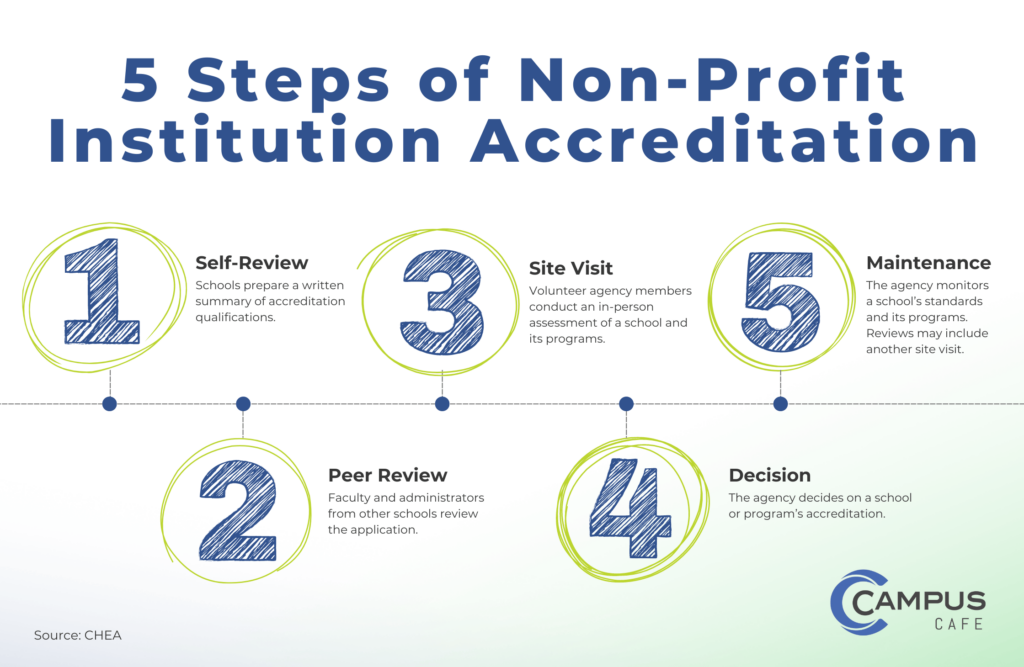
Accreditation Focus Areas for Universities and Liberal Arts Colleges
Below are broad focus areas that an accrediting agency may evaluate as it considers your school’s application for accreditation. Before undertaking the process, it’s a good idea to ensure your institution already has alignment on these areas.
Academic Offerings
The agency will assess the institution’s commitment to academic excellence, general education, and the breadth and depth of its academic offerings.
Programmatic and Institutional Areas of Accreditation
Colleges may have programmatic accreditation for specific professional programs (e.g., business, engineering, nursing) in addition to institutional accreditation, which covers a wide range of academic disciplines and ensures that the institution meets general standards of quality and effectiveness.
Degree Offerings
Accreditors may evaluate the institution’s ability to provide a comprehensive and rigorous education across different degree levels.
Duration of Programs
Accreditation for colleges assesses the institution’s ability to provide a well-rounded education over an extended period.
Workforce Preparedness
With an emphasis on broader educational goals, critical thinking skills, and the ability to adapt to various professional roles, colleges are assessed not only workforce preparation but also the institution’s commitment to developing well-rounded individuals.
Industry Collaborations and Scholarly Pursuits
Colleges may have collaborations with industries, but the focus is often broader, encompassing research, academic partnerships and a wide range of disciplines. The institution will be assessed on its commitment to academic and scholarly pursuits in addition to practical training.
General Accreditation Standards for Career, Trade, Technical and Vocational Schools
Like non-profits, a federally approved accrediting agency must also approve career and trade schools. However, they follow a slightly different process.
While rules can vary based on the accrediting body, general accreditation standards for trade and career schools include:
- Must be open for at least two years and have had one graduating class
- Provide credentials for at least an associate’s degree
- Indicate solid financials
- Comply with state licensing requirements, if applicable by industry or profession
- Offer programs with appropriate training and interactive instruction
- Provide appropriate programs, policies and procedures associated with the professional training
If a career or trade school meets the above standards, then they follow certain steps to begin the accreditation process.
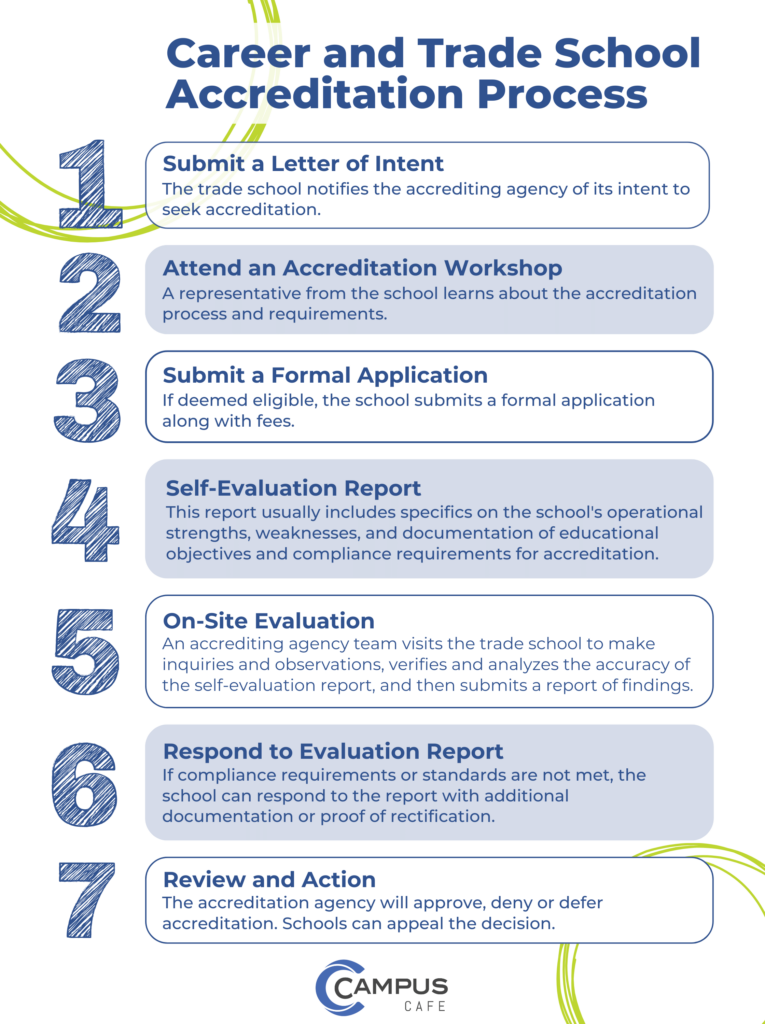
Focus Areas for Career and Trade School Accreditation Agencies
Similar to the focus areas for non-profit colleges and universities listed above, career and trade schools should ensure these focus areas are being broadly met before undertaking accreditation.
Educational Alignment
Accreditation often emphasizes the alignment of programs with industry standards and the development of skills necessary for entry into specific professions.
Programmatic Accreditation
Ensures that specific vocational programs meet industry standards and provide students with the skills needed for their chosen profession.
Degree Levels
Accreditation for trade schools assesses the quality of education provided at the certificate and associate degree levels.
Program Duration
Accreditation for trade schools may assess the efficiency and effectiveness of these shorter-term programs.
Graduate Success Rates
With an emphasis on preparing students for immediate entry into the workforce upon completion, accreditation often evaluates the success of graduates in securing employment in their respective fields.
Industry Collaboration
Accreditation may involve evaluating the strength of the school’s industry partnerships to ensure that their programs are aligned with current industry needs and standards.
V. Departments Involved in the Accreditation Process
At colleges and career schools alike, the accreditation process requires a lot of documentation. Below is a list of departments that may be involved in the process and the data their department would be responsible for providing.
By understanding who and what departments are involved in compiling information for accreditation, your team can simplify and streamline the process.
The Registrar
The Office of the Registrar provides information related to student records, enrollment data and academic transcripts. It is integral to demonstrating compliance with accreditation standards, particularly those related to academic and student-related matters.
Student Records and Enrollment Data
This information is essential for demonstrating the institution’s compliance with accreditation standards related to student achievement and outcomes.
Degree Programs and Academic Offerings
Accreditation bodies often require details on the curriculum and academic structure to ensure that programs meet established standards.
Plan of Study
Advisors and students work together to create a “plan of study” that tracks prerequisites, course completion and grades for graduation requirements. This information helps registrars track student performance and course availability for accreditation agencies.
Course Catalog and Curriculum
This documentation is vital for demonstrating that the institution offers a coherent and comprehensive curriculum.
Academic Policies and Procedures
Accreditation standards often require institutions to have clearly defined academic policies and procedures. The Registrar is involved in providing information on policies related to grading, academic integrity, credit hours, and other academic regulations.
Faculty Credentials
The Registrar’s office may contribute to the documentation of faculty credentials, ensuring that faculty members meet accreditation standards in terms of educational qualifications and expertise.
Enrollment Trends and Demographics
This information can be important for assessing institutional diversity and meeting accreditation standards related to student access and success.
Compliance with Accreditation Criteria
The Registrar collaborates with other departments to ensure that the institution’s academic programs and policies align with accreditation criteria. This includes verifying that degree requirements are met and that academic standards are upheld.
Transparency and Accessibility
The Registrar ensures that academic information is transparent and accessible to students, faculty, and other stakeholders, which aligns with accreditation standards related to institutional effectiveness and communication.
Data Accuracy and Integrity
The Registrar plays a critical role in maintaining the accuracy and integrity of academic and enrollment data. This is essential for providing reliable information to accreditation bodies during the evaluation process.
Communication with Accreditation Teams
During accreditation site visits, the Registrar may be involved in providing information to accreditation teams and responding to inquiries related to academic records, enrollment data and other Registrar-specific matters.
Finance and Financial Aid Offices
Accrediting bodies often assess an institution’s financial stability and resources as part of the accreditation process. The Financial Aid and Finance Offices may work together in order to provide financial information.
Financial Stability and Resources
Provides information on the financial health of the institution, including details on budgeting, endowments and financial aid resources.
Title IV Federal Financial Aid Programs
Institutions must be accredited to participate in Title IV federal financial aid programs, which include Pell Grants, Federal Direct Loans and other forms of federal aid. The Financial Aid Office ensures that the institution meets accreditation requirements to maintain eligibility for these programs.
Verification of Financial Aid Data
Accreditation reviews may include verification of financial aid data and processes. The Financial Aid Office provides documentation and evidence to support the accuracy and integrity of financial aid information.
Student Financial Support Services
The Financial Aid Office contributes to the institution’s commitment to student financial support services by providing information on scholarships, grants, work-study opportunities and counseling services related to financial aid.
Compliance With Financial Aid Regulations
Accrediting bodies may assess an institution’s compliance with federal and state financial aid regulations. The Financial Aid Office ensures that the institution adheres to these regulations and that its financial aid practices meet the required standards.
Default Rates and Student Loan Management
The Financial Aid Office monitors student loan default rates and implements strategies to manage and reduce default rates. Accrediting bodies may consider default rates as part of their assessment of an institution’s financial health and the effectiveness of its student support services.
Communication With Accreditation Teams
During accreditation site visits, the Financial Aid Office may be involved in providing information to accreditation teams and responding to inquiries related to financial aid practices, policies and the impact on student success.
Financial Aid Policies and Procedures
Accrediting bodies assess the institution’s commitment to fair and transparent financial aid practices, ensuring that students have access to necessary financial resources.
Audits and Compliance Reviews
The Financial Aid Office collaborates with auditors and compliance officers to undergo financial aid audits and reviews. Accrediting bodies may consider the results of these audits as part of their assessment of the institution’s financial management.
Budgeting and Resource Allocation
Accreditation standards often require institutions to demonstrate responsible budgeting and resource allocation. The Financial Aid Office provides information on how financial aid resources are budgeted and allocated to support students.
IT Department
The IT department is often considered “behind-the-scenes,” but their job is critical to the accreditation process. IT staff provide technical support, ensure data accuracy, manage information systems and contribute to the overall efficiency of accreditation-related activities.
Data Management
IT professionals manage and maintain databases that store critical information relevant to the accreditation process, including student enrollment, academic programs, faculty qualifications and institutional resources.
Integration of Information Systems
Accreditation often requires the integration of various information systems across departments. IT professionals work to ensure seamless integration, allowing for efficient data sharing and communication among different systems.
Security and Data Privacy
IT professionals implement security measures to protect sensitive accreditation-related data.
They work to ensure compliance with data privacy regulations and safeguard information against unauthorized access or breaches.
Electronic Submission of Accreditation Materials
IT professionals facilitate the electronic submission of accreditation materials. This involves creating secure online self-service portals through which institutions can submit documentation, reports and other required materials to accrediting bodies.
Document Management Systems
IT professionals implement and manage document management systems that enable institutions to organize, store and retrieve accreditation-related documents efficiently. This ensures that all required documentation is readily available for accreditation reviews.
Website and Online Presence
IT professionals contribute to the institution’s online presence, ensuring that the official website accurately reflects accreditation status, provides relevant information about the accreditation process and serves as a resource for stakeholders seeking accreditation-related information.
Data Analytics and Reporting
IT professionals support the generation of reports and analytics required for accreditation purposes. They work with institutional researchers and other departments to extract, analyze and present data in a format that meets accreditation standards.
Technology Infrastructure
IT professionals ensure that the institution’s technology infrastructure supports accreditation-related activities, including the availability and reliability of servers, network connectivity and other technical resources required for smooth accreditation processes.
Training and Support
IT professionals are involved in the training and support users involved in the accreditation process. This includes training on the use of accreditation-related software like a student information system.
Collaboration With Accreditation Teams
During accreditation site visits, IT professionals may collaborate with accreditation teams to provide technical support, access to data and assistance with any technology-related aspects of the accreditation review.
Backup and Disaster Recovery Planning
IT professionals implement backup and disaster recovery plans to ensure the availability of critical accreditation data in case of unforeseen events. This contributes to the overall reliability of accreditation-related information systems.
Other Key Stakeholders
In addition to the departments listed above, faculty members, department chairs or heads, and members of the academic affairs or provost’s offices may also be involved. These stakeholders may be asked to provide information related to academic programs, program outcomes, faculty qualifications, instructional methods, research, curriculum development and other academic matters.
VI. How a Student Information System Helps Schools Meet Accreditation Requirements
Because accreditation requires a significant investment of time and resources from many departments, managing student data and institutional documents across various spreadsheets and databases isn’t ideal.
Whether working toward accreditation or applying for a renewal, below we share how the features of Campus Cafe’s student information system can help you comply with common accreditation standards. While these differ between accrediting agencies, it often includes standards related to student success, financial stability, governance, academic quality, faculty qualifications and institutional resources.
Student Retention Tools
Degree audits and plans of study help students keep track of degree requirements to improve student retention and graduation rates.
Communication and Collaboration Tools
Advisors can access student profiles through a built-in CRM to review academic history and performance, and communicate directly with students, faculty or other departments.
User-Friendly Experience
Easily transfer information through self-service portals, including retrieving grades, transcripts or receiving financial aid information.
Learning Management System (LMS) Integration
Collate information about course offerings, syllabi and program requirements to demonstrate that academic programs align with accreditation standards.
Customizable Reports and Dashboards
Generate all the essential reports for compliance with accrediting bodies, including reports on student demographics, faculty qualifications, school finances, graduation rates and career placement.
Financial Aid Module
Efficiently package, disburse and manage financial aid in-house, with a third-party service provider or via an integration with a third-party system, like EdExpress.
Secure, Cloud-Based Software
Accreditation bodies often require institutions to demonstrate the security and privacy of student data, including disaster recovery plans and permission-based access of information.
Student Financial Management
A student financial ledger, online billing and payment collection software promotes financial transparency and helps demonstrate financial stability.
A Single Source of Truth
A central repository for information minimizes redundant data entry, manual work and makes data easily accessible for auditors, accreditors or financial aid service providers.
The Bottom Line: An SIS Supports Accreditation Administration
Accreditation sets your institution apart. It provides an important boost for recruiting, marketing and enrollment, and affirms a school’s commitment to a high-quality education and professional development.
The accreditation process is where a student information system can shine: Everyone can access real-time information from a single source of truth. It not only helps your school better manage its data, but it also alleviates stress on your staff, reduces time-consuming manual work, and helps maintain important records for compliance, accreditation applications and renewals.
Ready to see how Campus Cafe can streamline your school’s accreditation process? Contact us for a free demo.


